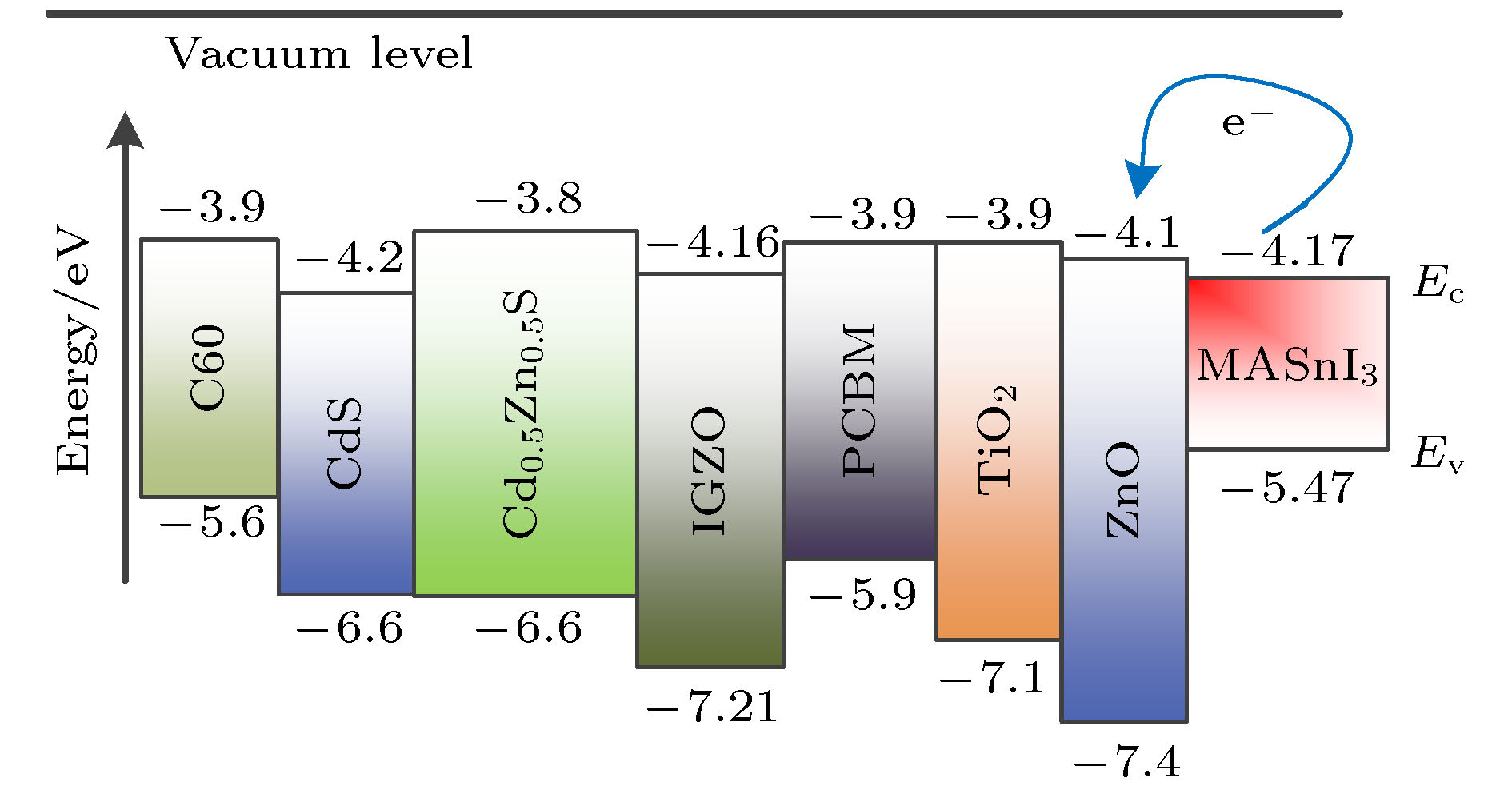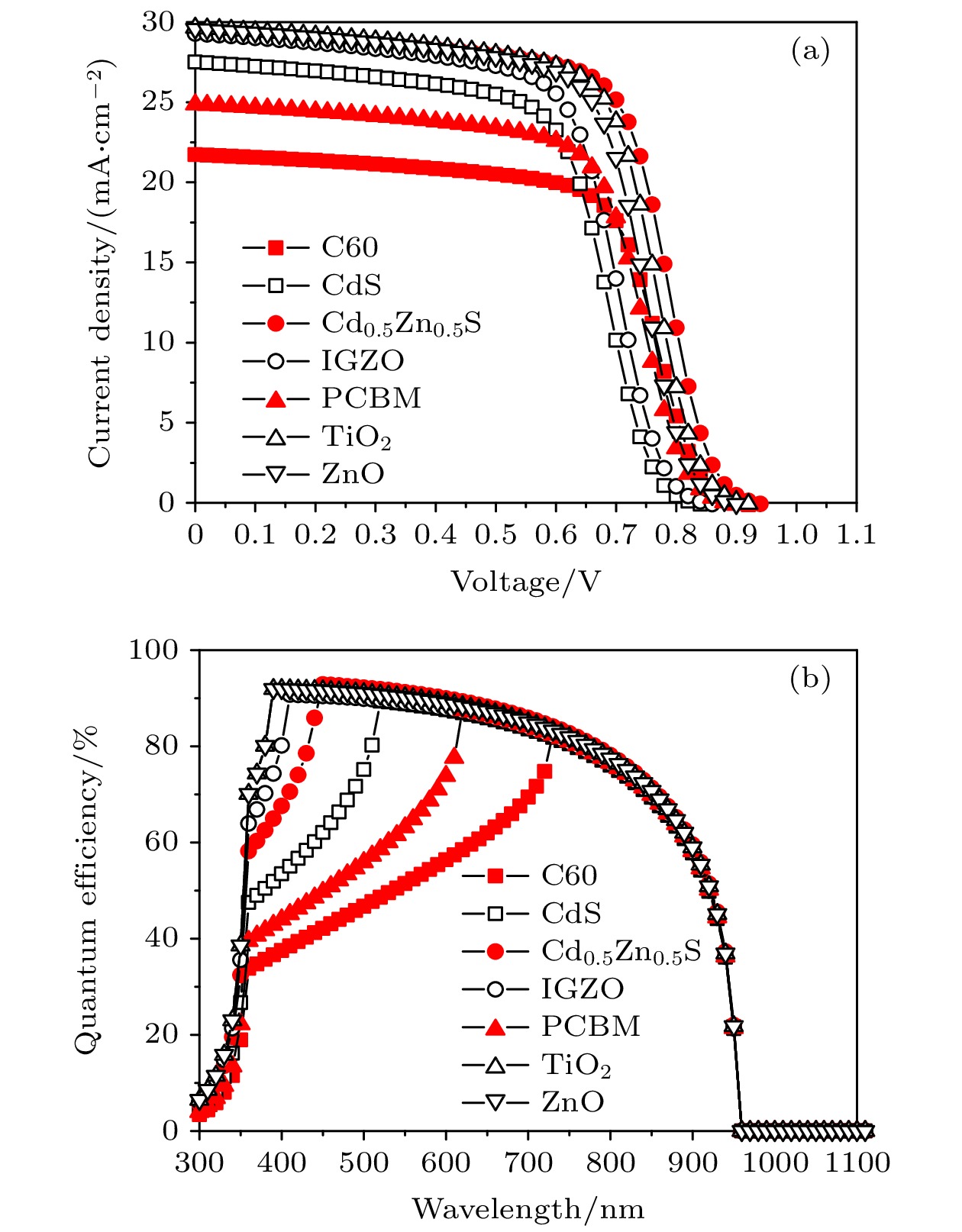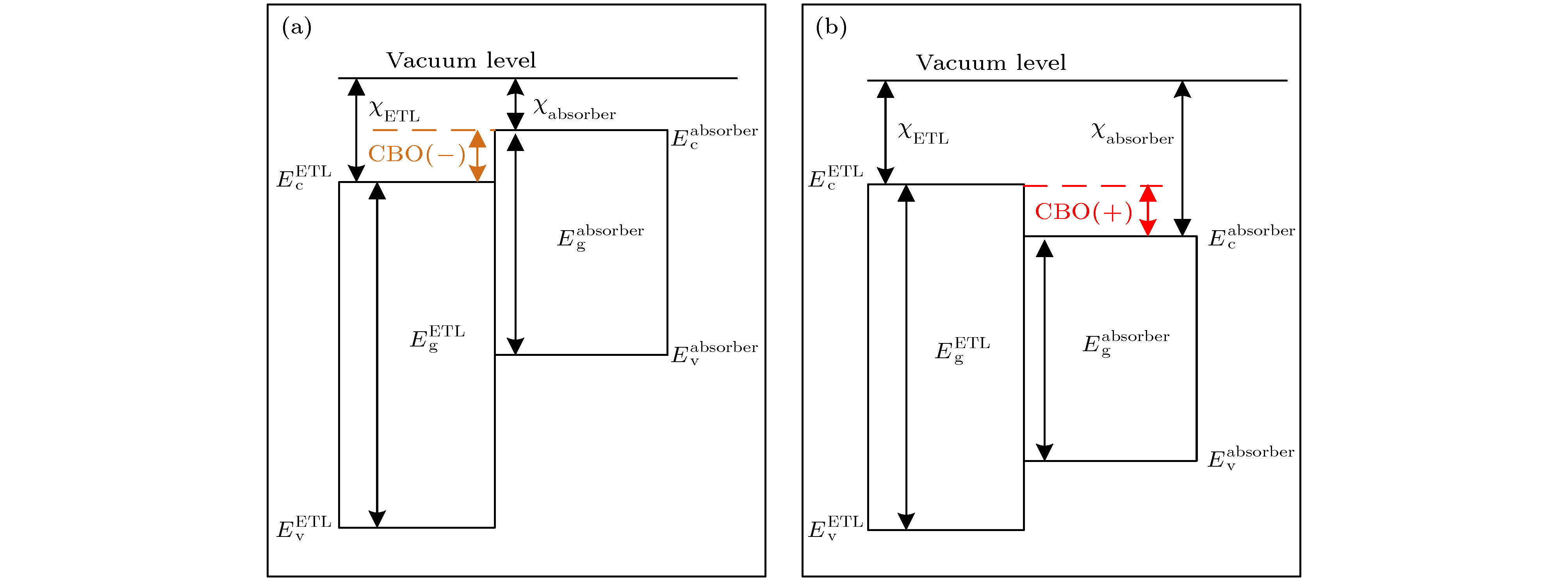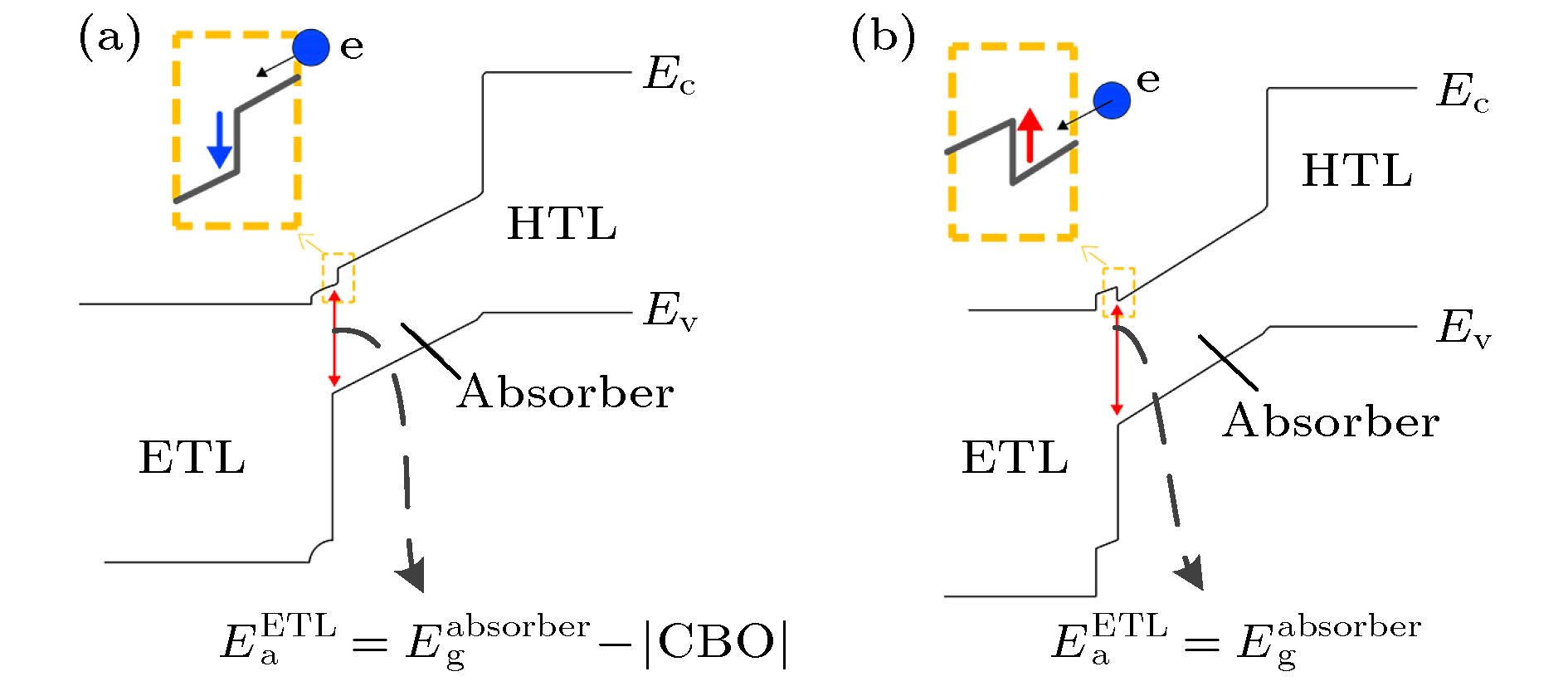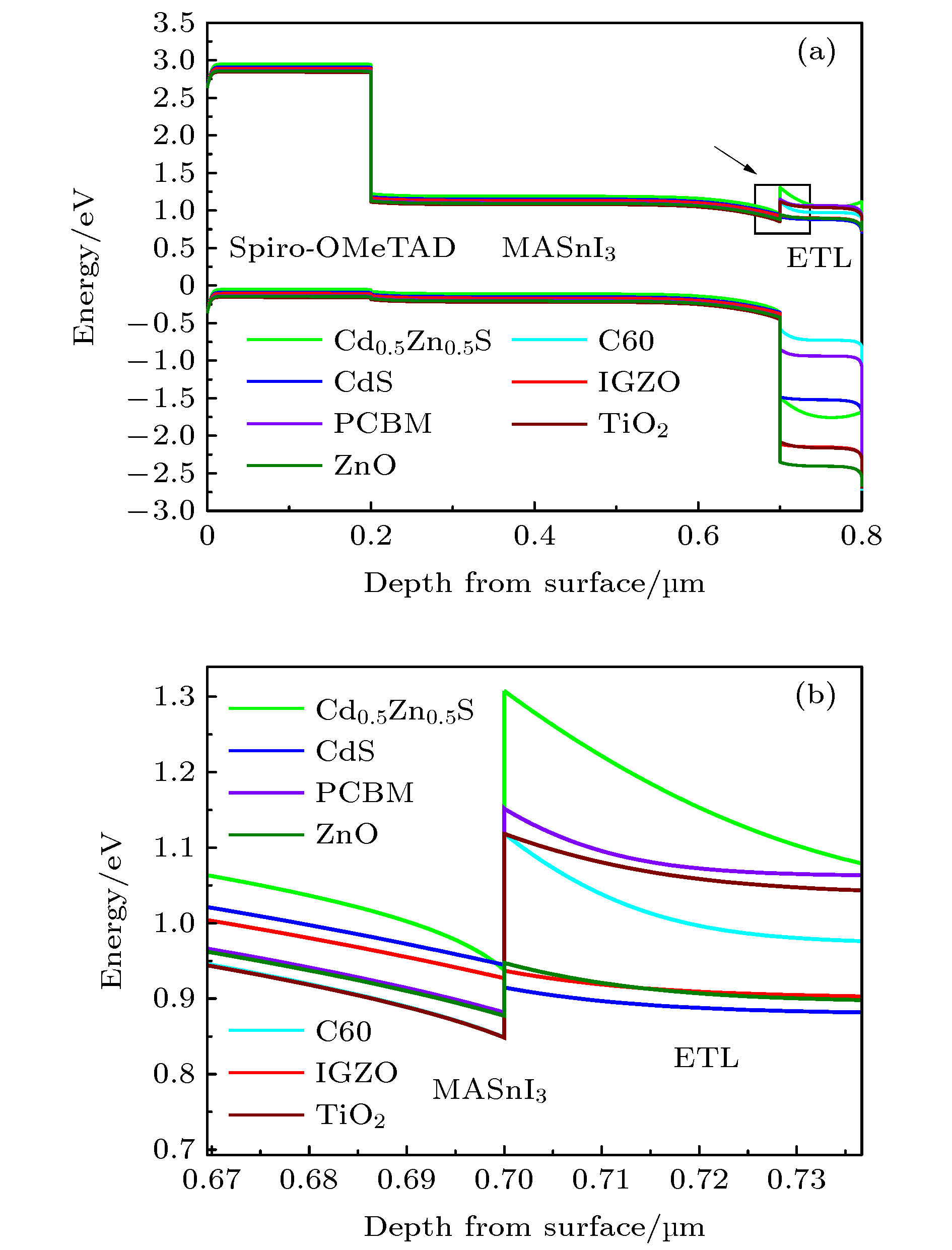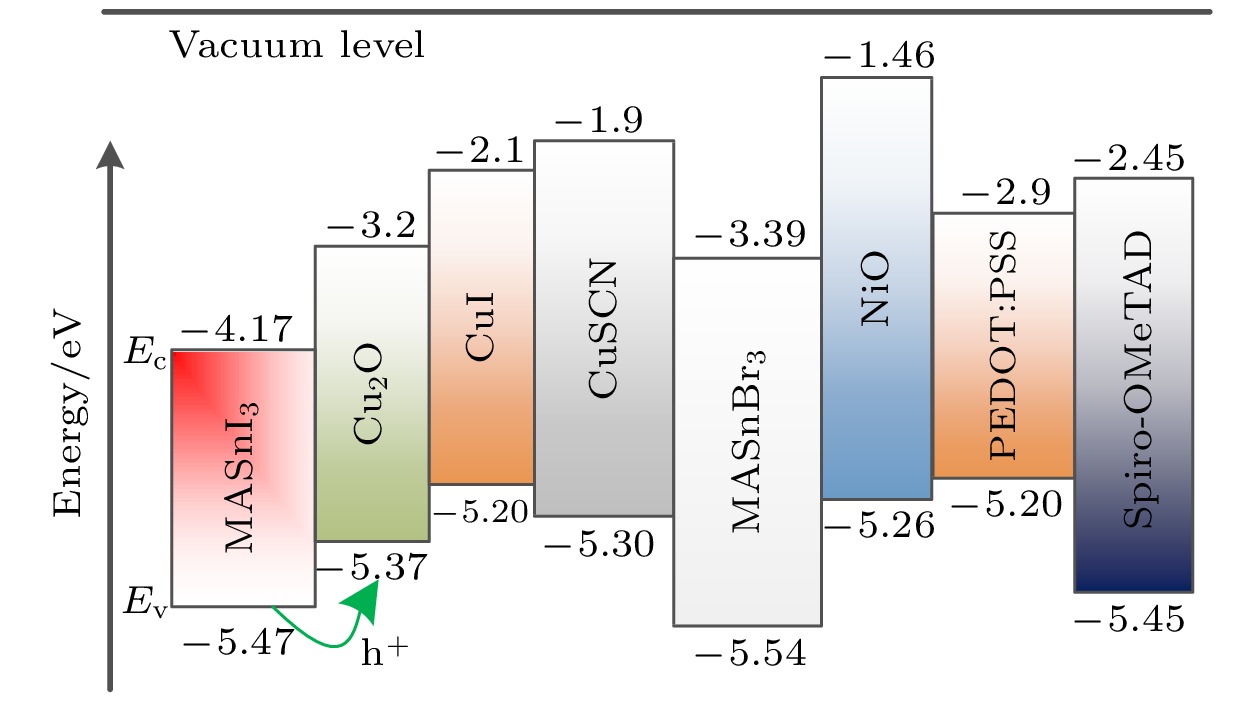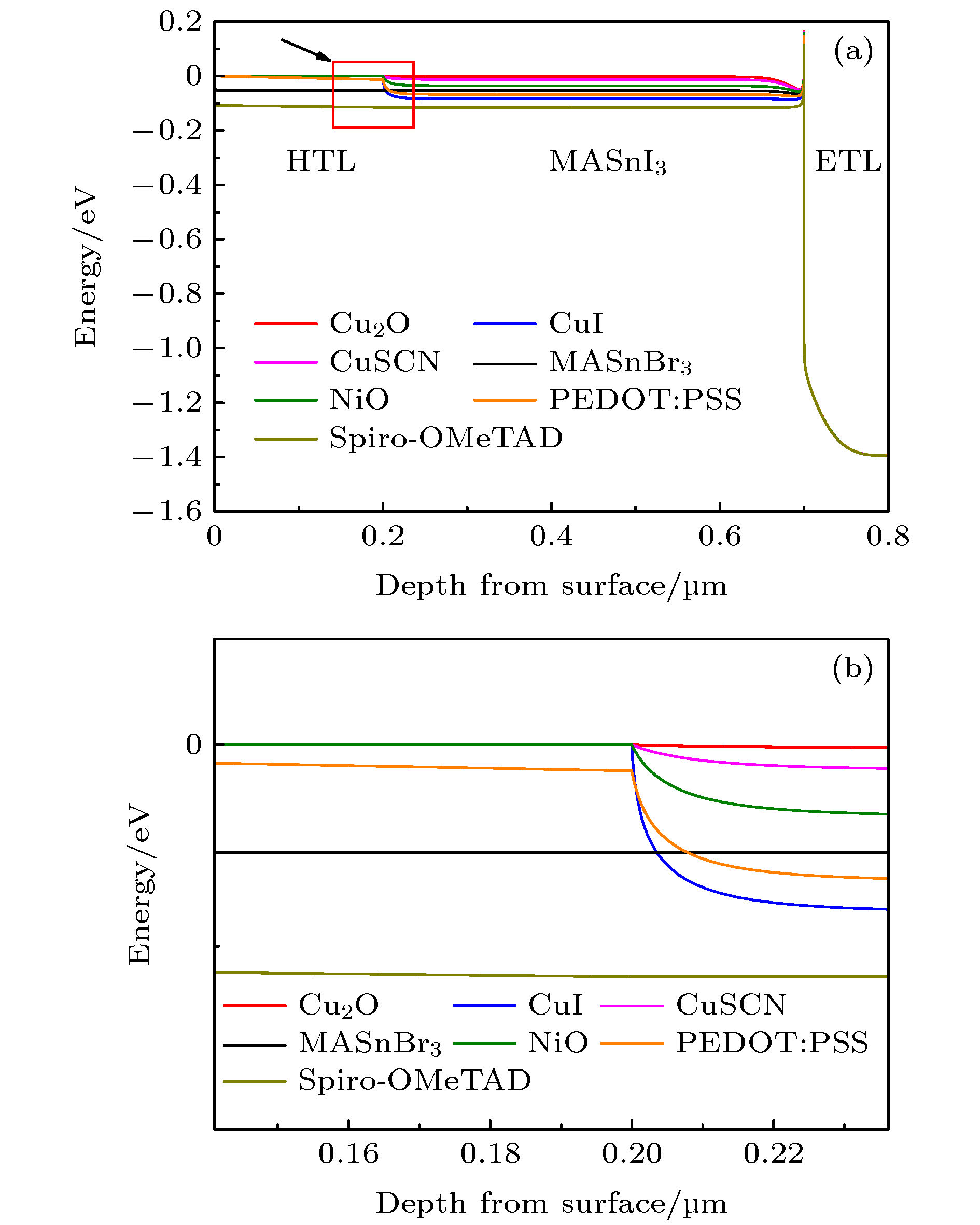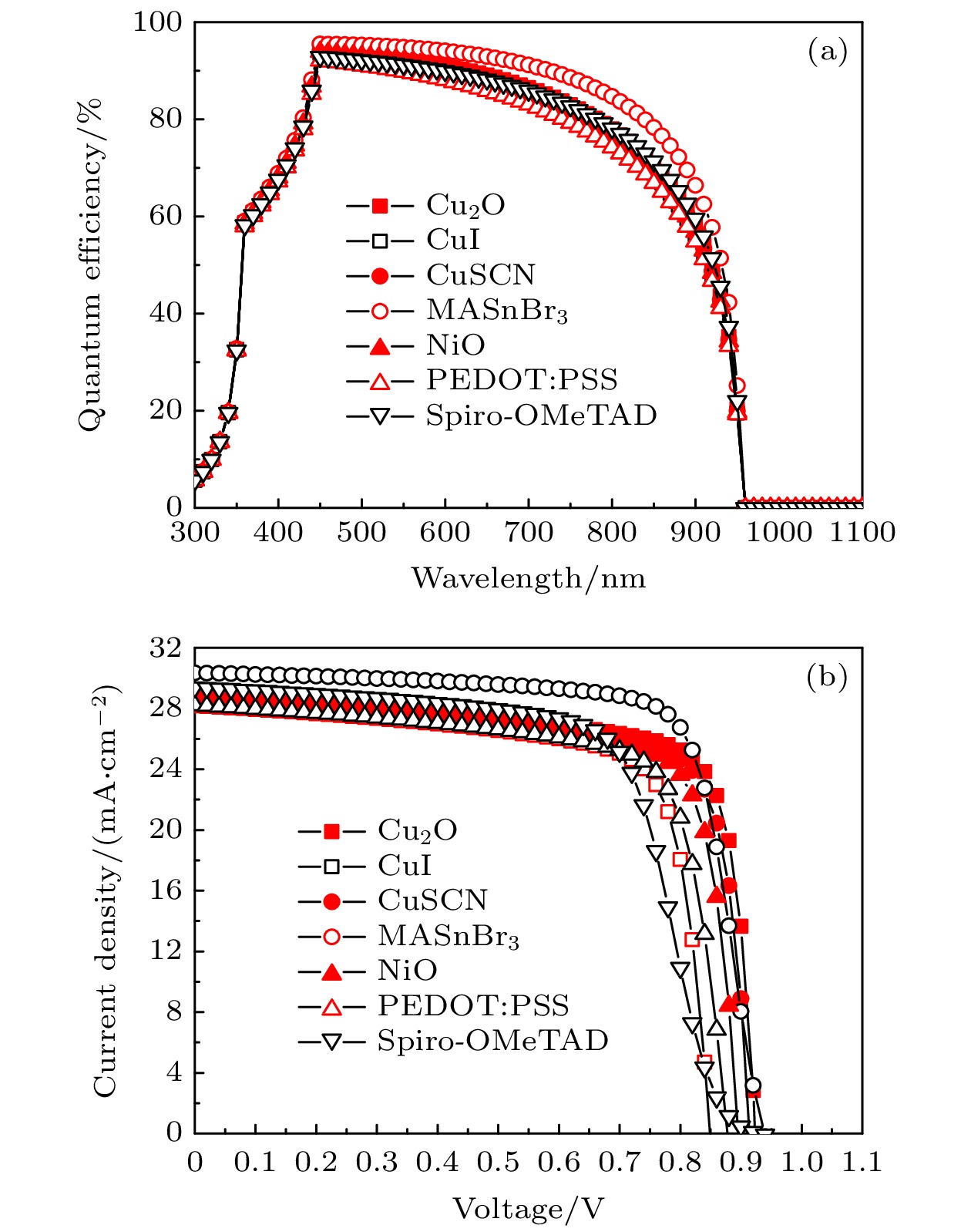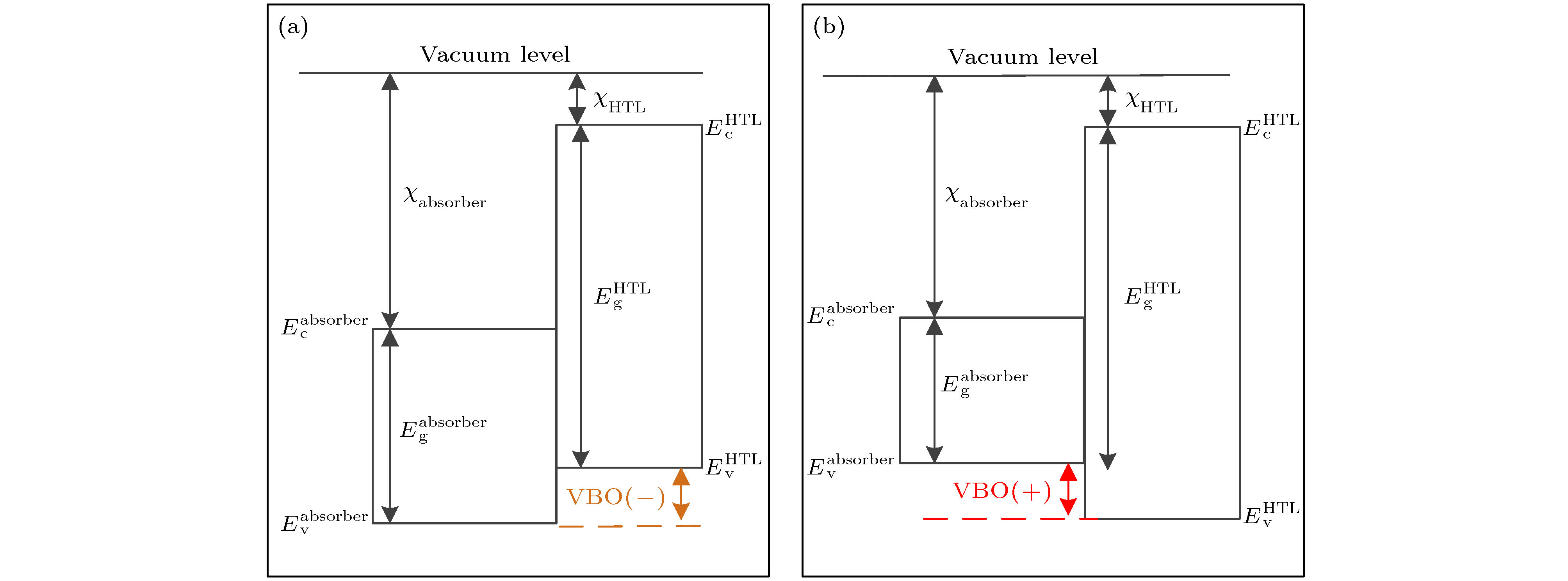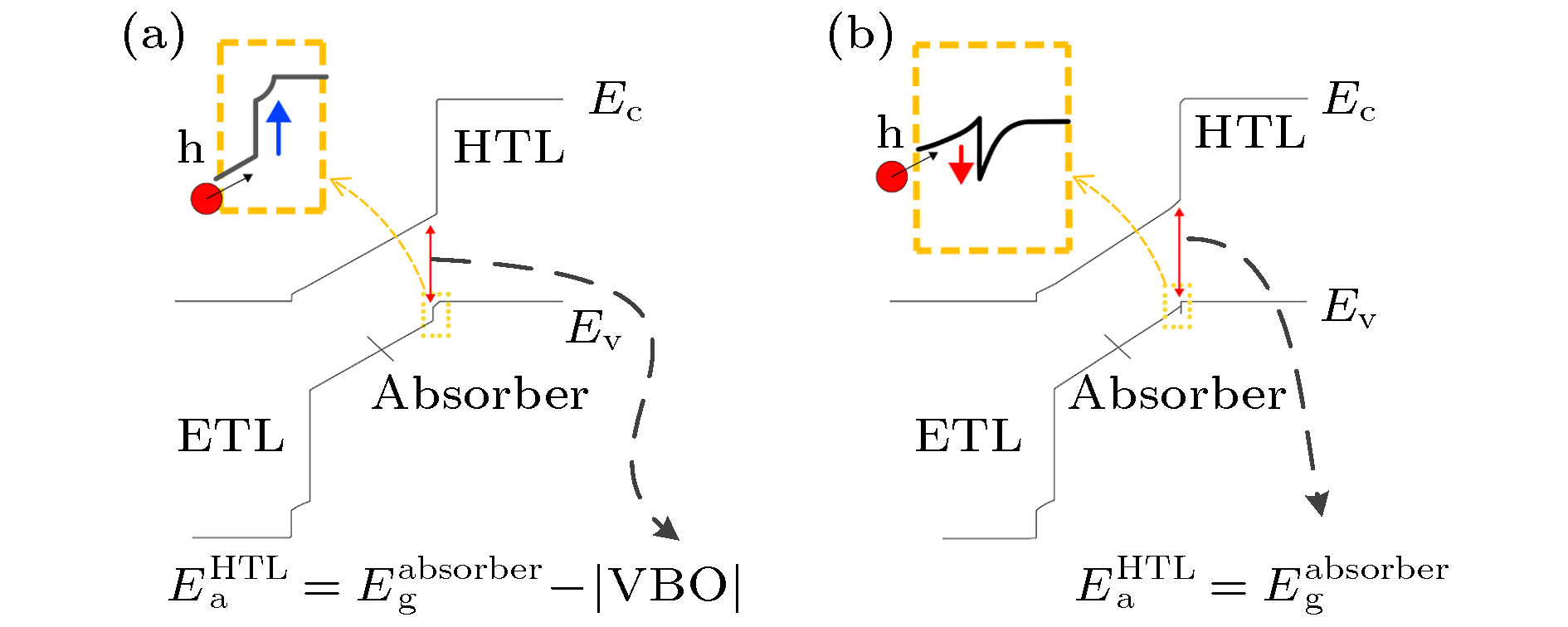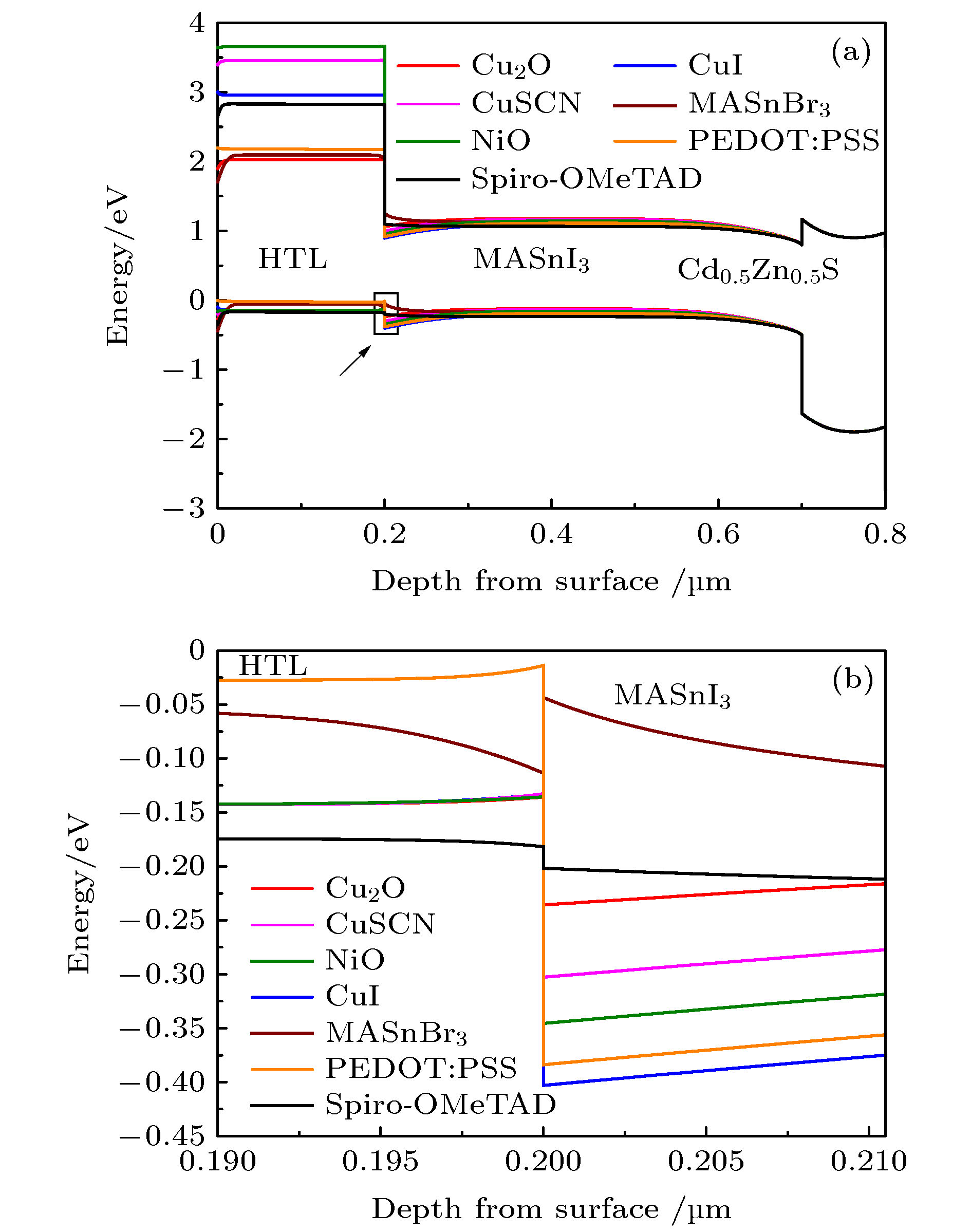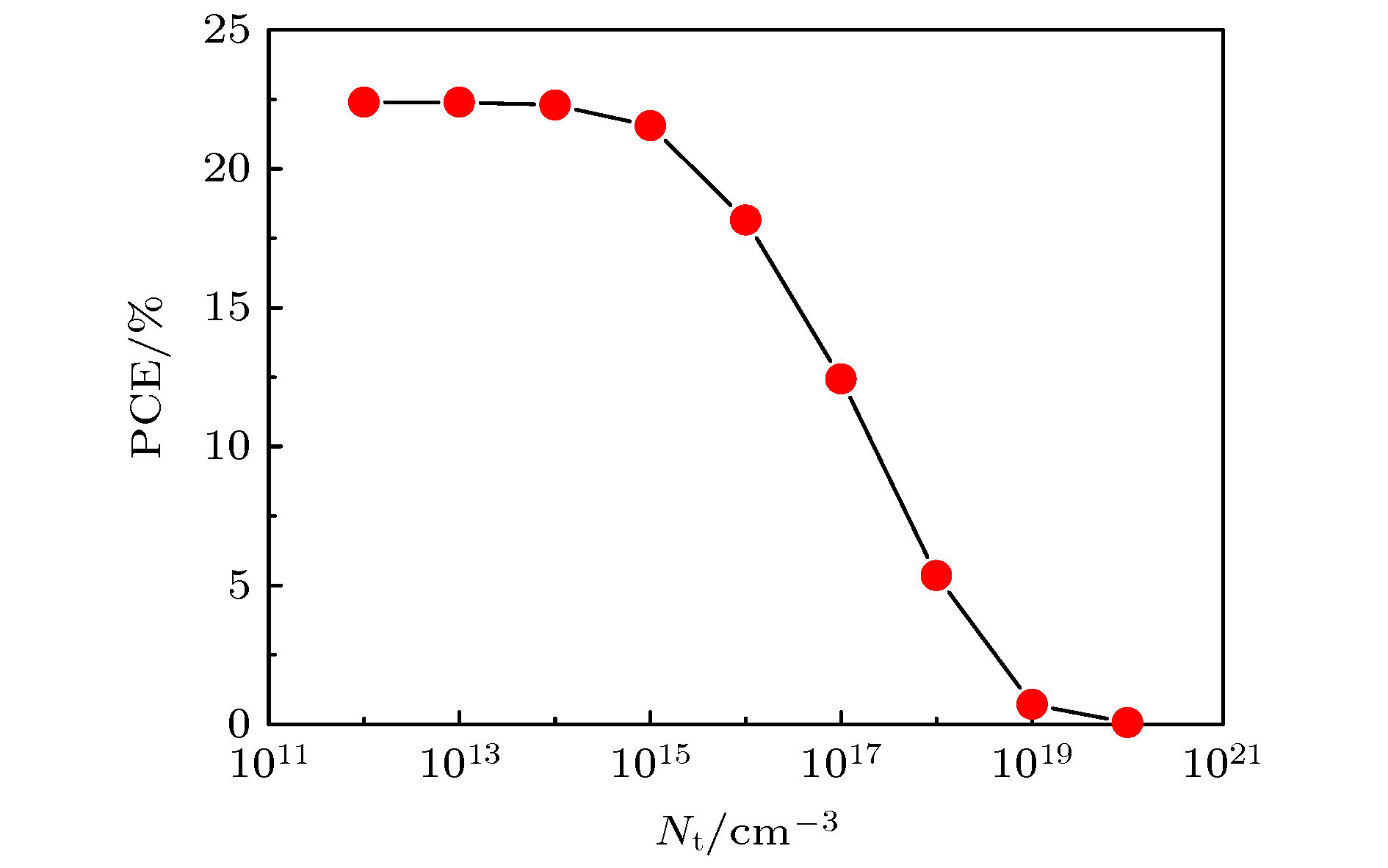-
To avoid environmental pollution caused by lead, the tin-based perovskite solar cells have become a research hotspot in the photovoltaic field. Numerical simulations of tin-based perovskite solar cells are conducted by the solar cell simulation software, SCAPS-1D, with different electron transport layers and hole transport layers. And then the performances of perovskite solar cells are compared with each other and analyzed on different carrier transport layers. The results show that band alignment between the carrier transport layer and the perovskite layer are critical to cell performances. A higher conduction band or electronic quasi-Fermi level of electron transport layer can lead to a higher open circuit voltage. Similarly, a lower valence band or hole quasi-Fermi level of hole transport layer can also promote a higher open circuit voltage. In addition, when the conduction band of electron transport layer is higher than that of the absorber, a spike barrier is formed at the interface between the electron transport layer and perovskite layer. Nevertheless, a spike barrier is formed at the interface between the perovskite layer and the hole transport layer if the valence band of hole transport layer is lower than that of the absorber. However, if the conduction band of electron transport layer is lower than that of the absorber or the valence band of hole transport layer is higher than that of the absorber, a cliff barrier is formed. Although the transport of carrier is hindered by spike barrier compared with cliff barrier, the activation energy for carrier recombination becomes lower than the bandgap of the perovskite layer, leading to the weaker interface recombination and the better performance. Comparing with other materials, satisfying output parameters are obtained when Cd0.5Zn0.5S and MASnBr3 are adopted as the electron transport layer and the hole transport layer, respectively. The better performances are obtained as follows: Voc = 0.94 V, Jsc = 30.35 mA/cm2, FF = 76.65%, and PCE = 21.55%, so Cd0.5Zn0.5S and MASnBr3 are suitable carrier transport layer materials. Our researches can help to design the high-performance tin-based perovskite solar cells.
-
Keywords:
- tin-based perovskite solar cell /
- quasi-Fermi level /
- electron transport layer /
- hole transport layer
[1] Eperon G E, Burlakov V M, Docampo P, Goriely A, Snaith H J 2014 Adv. Funct. Mater. 24 151
 Google Scholar
Google Scholar
[2] Liu M, Johnston M B, Snaith H J 2013 Nature 501 395
 Google Scholar
Google Scholar
[3] 梁晓娟, 曹宇, 蔡宏琨, 苏健, 倪牮, 李娟, 张建军 2020 物理学报 69 057901
 Google Scholar
Google Scholar
Liang X J, Cao Y, Cai H K, Su J, Ni J, Li J, Zhang J J 2020 Acta Phys. Sin. 69 057901
 Google Scholar
Google Scholar
[4] Conings B, Drijkoningen J, Gauquelin N, et al. 2015 Adv. Energy Mater. 5 1500477
 Google Scholar
Google Scholar
[5] Wang R, Mujahid M, Duan Y, Wang Z K, Xue J, Yang Y 2019 Adv. Funct. Mater. 29 1808843
 Google Scholar
Google Scholar
[6] Wang Q, Phung N, Di Girolamo D, Vivo P, Abate A 2019 Energy Environ. Sci. 12 865
 Google Scholar
Google Scholar
[7] Liang J, Liu J, Jin Z 2017 Solar RRL 1 1700086
 Google Scholar
Google Scholar
[8] Yang T C, Fiala P, Jeangros Q, Ballif C 2018 Joule 2 1421
 Google Scholar
Google Scholar
[9] Chen H, Xiang S, Li W, Liu H, Zhu L, Yang S 2018 Solar RRL 2 1700188
 Google Scholar
Google Scholar
[10] Song T, Yokoyama T, Aramaki S, Kanatzidis M G 2017 ACS Energy Letters 2 897
 Google Scholar
Google Scholar
[11] Green MA, Ho-Baillie A, Snaith HJ 2014 Nat. Photonics 8 506
 Google Scholar
Google Scholar
[12] Kojima A, Teshima K, Shirai Y, Miyasaka T 2009 J. Am. Chem. Soc. 131 6050
 Google Scholar
Google Scholar
[13] Baig F, Khattak Y H, Marí B, Beg S, Ahmed A, Khan K 2018 J. Electron. Mater. 47 5275
 Google Scholar
Google Scholar
[14] Chen M, Ju M, Carl A D, Zong Y, Grimm R L, Gu J, Zeng X C, Zhou Y, Padture N P 2018 Joule 2 558
 Google Scholar
Google Scholar
[15] Chakraborty K, Choudhury MG, Paul S 2019 Sol. Energy 194 886
 Google Scholar
Google Scholar
[16] Islam M A, Rahman K S, Misran H, Asim N, Hossain M S, Akhtaruzzaman M, Amin N 2019 Results Phys. 14 102518
 Google Scholar
Google Scholar
[17] Lakhdar N, Hima A 2020 Opt. Mater. 99 109517
 Google Scholar
Google Scholar
[18] Azri F, Meftah A, Sengouga N, Meftah A 2019 Sol. Energy 181 372
 Google Scholar
Google Scholar
[19] Sajid, Elseman A M, Ji J, Dou S, Huang H, Cui P, Wei D, Li M 2018 Chin. Phys. B 27 80
 Google Scholar
Google Scholar
[20] Minemoto T, Murata M 2014 Curr. Appl. Phys. 14 1428
 Google Scholar
Google Scholar
[21] Teimour R, Mohammadpour R 2018 Superlattices Microstruct. 118 116
 Google Scholar
Google Scholar
[22] Du H J, Wang W C, Zhu J Z 2016 Chin. Phys. B 25 108802
 Google Scholar
Google Scholar
[23] Chouhan A S, Jasti N P, Avasthi S 2018 Mater. Lett. 221 150
 Google Scholar
Google Scholar
[24] Huang S, Rui Z, Chi D, Bao D 2019 Journal of Semiconductors 40 19
 Google Scholar
Google Scholar
[25] Lin L Y, Jiang L Q, Qiu Y, Fan B D 2018 J. Phys. Chem. Solids 122 19
 Google Scholar
Google Scholar
[26] Lin L Y, Jiang L Q, Li P, Fan B D, Qiu Y 2019 J. Phys. Chem. Solids 124 205
 Google Scholar
Google Scholar
[27] Wang D, Wu C, Luo W, Guo X, Qu B, Xiao L, Chen Z 2018 ACS Appl. Energy Mater. 1 2215
 Google Scholar
Google Scholar
[28] Minemoto T, Murata M 2015 Sol. Energy Mater. Sol. Cells 133 8
 Google Scholar
Google Scholar
[29] Klenk R 2001 Thin Solid Films 387 135
 Google Scholar
Google Scholar
[30] Gloeckler M, Sites J 2005 Thin Solid Films 480 241
 Google Scholar
Google Scholar
[31] Minemoto T, Hashimoto Y, Satoh T, Negami T, Takakura H, Hamakawa Y 2001 J. Appl. Phys. 89 8327
 Google Scholar
Google Scholar
[32] Minemoto T, Hashimoto Y, Satoh T, et al. 2003 Sol. Energ. Mater. Sol. Cells 75 121
 Google Scholar
Google Scholar
[33] Torndahl T, Platzer-Bjorkman C, Kessler J, Edoff M 2007 Prog. Photovolt 15 225
 Google Scholar
Google Scholar
[34] Minemoto T, Matsui T, Takakura H, et al. 2001 Sol. Energ. Mater. Sol. Cells 67 83
 Google Scholar
Google Scholar
[35] Ryu S, Noh J H, Jeon N J, Chan Kim Y, Yang W S, Seo J, Seok S I 2014 Energy Environ. Sci. 7 2614
 Google Scholar
Google Scholar
[36] Tanaka K, Minemoto T, Takakura H 2009 Sol. Energy 83 477
 Google Scholar
Google Scholar
[37] Karimi E, Ghorashi S M B 2017 J. Nanophotonics 11 032510
 Google Scholar
Google Scholar
[38] 蒙镜蓉, 李国龙, 索鑫磊, 张立来, 苏杭, 李婉, 王浩 2019 激光与光电子学进展 56 261
Meng J R, Li G L, Suo X L, Zhang L L, Su H, Li W, Wang H 2019 L. & O. Progress 56 261
[39] Gao F Q, Li C H, Qin L, Zhu L J, Huang X, Liu H, Liang L, Hou Y B, Lou Z D, Hu Y F, Teng F 2018 RSC Adv. 8 14025
 Google Scholar
Google Scholar
[40] Adhikari K R, Gurung S, Bhattarai B K, Soucase B M 2016 Phys. Status Solidi C 13 13
 Google Scholar
Google Scholar
[41] 林灵燕, 范宝殿 2017 泉州师范学院学报 36 50
Lin L Y, Fan B D 2017 J. Quanzhou Normal Univ. 36 50
[42] Devi N, Parrey K A, Aziz A, Datta S 2018 J. Vac. Sci. Technol. B 36 105
 Google Scholar
Google Scholar
[43] 孙亚平, 陈慧颖, 陈高玲, 王多发, 章天金 2018 湖北大学学报 40 518
Sun Y P, Chen H Y, Chen G L, Wang D F, Zhang T J 2018 J. Hubei Univ. 40 518
[44] 李毅, 朱俊, 张旭辉, 戴松元 2019 太阳能学报 40 2630
Li Y, Zhu J, Zhang X H, Dai S Y 2019 Acta Energ. Sol. Sin. 40 2630
[45] Hao F, Stoumpos C C, Cao D H, Chang R P, Kanatzidis M G 2014 Nat. Photonics 8 489
 Google Scholar
Google Scholar
[46] Noel N K, Stranks S D, Abate A, et al. 2014 Energy Environ. Sci. 7 3061
 Google Scholar
Google Scholar
[47] Hossain M I, Alharbi F H, Tabet N 2015 Sol. Energy 120 370
 Google Scholar
Google Scholar
-
表 1 基本仿真参数
Table 1. Basic simulation parameters.
Parameter SnO2:F TiO2 MASnI3 spiro-OMeTAD Thickness/nm 500 [13] 100 [21] 500 [13] 200 [18] Eg/eV 3.5 [13] 3.2 [18] 1.3 [13] 3.0 [20] χ/eV 4.0 [13] 3.9 [18] 4.17 [13] 2.45 [20] εr 9.0 [13] 9.0 [18] 8.2 [13] 3.0 [20] Nc/cm–3 1 × 1019 [13] 1 × 1021 [18] 1 × 1018 [13] 1 × 1019 [21] Nv/cm–3 1 × 1019 [13] 2 × 1020 [18] 1 × 1018 [13] 1 × 1019 [21] μn/(cm2·V·s–1) 100 [13] 20 [18] 1.6 [13] 0.0002 [20] μp/(cm2·V·s–1) 25 [13] 10 [18] 1.6 [13] 0.0002 [20] Nd/cm–3 2 × 1019 [13] 1 × 1017 [18] 0 [13] 0 [20] Na/cm–3 0 [13] 0 [18] 1 × 1016 [13] 2 × 1018 [20] Nt/cm–3 1 × 1015 [18] 1 × 1015 [18] 1 × 1015 [13] 1 × 1015 [20] 表 2 不同ETL材料的参数
Table 2. Input parameters of the proposed ETL materials.
Parameter C60 CdS Cd0.5Zn0.5S IGZO PCBM ZnO Eg/eV 1.7 [17] 2.4 [25] 2.8 [13] 3.05 [18] 2 [18] 3.3 [17] χ/eV 3.9 [17] 4.2 [25] 3.8 [13] 4.16 [18] 3.9 [18] 4.1 [17] εr 4.2 [17] 10 [25] 10 [13] 10 [18] 3.9 [18] 9 [17] Nc/cm–3 8 × 1019 [17] 2.2 × 1018 [25] 1 × 1018 [13] 5 × 1018 [18] 2.5 × 1021 [18] 4 × 1018 [17] Nv/cm–3 8 × 1019 [17] 1.8 × 1019 [25] 1 × 1018 [13] 5 × 1018 [18] 2.5 × 1021 [18] 1 × 1019 [17] μn/(cm2·V·s–1) 0.08 [17] 100 [25] 100 [13] 15 [18] 0.2 [18] 100 [17] μp/(cm2·V·s–1) 0.0035 [17] 25 [25] 25 [13] 0.1 [18] 0.2 [18] 25 [17] Nd/cm–3 2.6 × 1018 [17] 1 × 1017 [25] 1 × 1017 [13] 1 × 1018 [18] 2.93 × 1017 [18] 1 × 1018 [26] Na/cm–3 0 [17] 0 [25] 0 [13] 0 [18] 0 [18] 0 [26] Nt/cm–3 1 × 1014 [17] 1 × 1017 [25] 1 × 1015 [13] 1 × 1015 [18] 1 × 1015 [18] 1 × 1015 [26] 表 3 不同HTL材料的参数
Table 3. Input parameters of the proposed HTL materials.
Parameter Cu2O CuI CuSCN MASnBr3 NiO PEDOT:PSS Eg/eV 2.17 [26] 2.98 [18] 3.4 [18] 2.15 [13] 3.8 [18] 2.2 [18] χ/eV 3.2 [26] 2.1 [18] 1.9 [18] 3.39 [13] 1.46 [18] 2.9 [18] εr 6.6 [20] 6.5 [18] 10 [18] 8.2 [13] 11.7 [20] 3 [18] Nc/cm–3 2.5 × 1020 [20] 2.8 × 1019 [18] 1.7 × 1019 [18] 1 × 1018 [13] 2.5 × 1020 [20] 2.2 × 1015 [18] Nv/cm–3 2.5 × 1020 [20] 1 × 1019 [18] 2.5 × 1021 [18] 1 × 1018 [13] 2.5 × 1020 [20] 1.8 × 1018 [18] μn/(cm2·V·s–1) 80 [20] 0.00017 [18] 0.0001 [18] 1.6 [13] 2.8 [20] 0.02 [18] μp/(cm2·V·s–1) 80 [20] 0.0002 [18] 0.1 [18] 1.6 [13] 2.8 [20] 0.0002 [18] Nd/cm–3 0 [20] 0 [18] 0 [18] 0 [13] 0 [18] 0 [18] Na/cm–3 1 × 1018 [26] 1 × 1018 [18] 1 × 1018 [18] 1 × 1018 [13] 1 × 1018 [18] 3.17 × 1014 [18] Nt/cm–3 1 × 1015 [26] 1 × 1015 [18] 1 × 1014 [18] 1 × 1015 [13] 1 × 1014 [18] 1 × 1015 [18] 表 4 不同ETL材料的PSC输出参数
Table 4. Effects of ETLs on output parameters of the PSCs.
Parameter C60 CdS Cd0.5Zn0.5S IGZO PCBM TiO2 ZnO Voc/V 0.84 0.81 0.93 0.82 0.83 0.84 0.83 Jsc/(mA·cm–2) 21.73 27.50 29.39 29.27 24.86 29.64 29.58 FF/% 69.47 62.62 64.73 63.95 67.53 69.27 67.72 PCE/% 12.66 14.01 17.70 15.32 13.92 17.24 16.64 表 5 CBO、界面势垒结构及
$E_{\rm{a}}^{{\rm{ETL}}}$ 的关系Table 5. Relationship between CBO, barrier shape and
$E_{\rm{a}}^{{\rm{ETL}}}$ .Parameter C60 CdS Cd0.5Zn0.5S IGZO PCBM TiO2 ZnO CBO/eV 0.27 –0.03 0.37 0.01 0.27 0.27 0.07 Barrier shape spike cliff spike spike spike spike spike $E_{\rm{a}}^{{\rm{ETL}}}$/eV 1.3 1.27 1.3 1.3 1.3 1.3 1.3 表 6 不同HTL材料的PSC输出参数
Table 6. Effect of HTL on output parameters of the PSCs.
Parameter Cu2O CuI CuSCN MASnBr3 NiO PEDOT:PSS spiro-OMeTAD Voc/V 0.92 0.85 0.91 0.94 0.90 0.88 0.93 Jsc/(mA·cm–2) 28.71 28.18 28.45 30.35 28.32 28.21 29.39 FF/% 76.49 74.32 75.74 76.65 75.04 73.30 64.73 PCE/% 20.28 17.79 19.71 21.55 19.04 18.15 17.70 表 7 VBO、界面势垒结构及
$E_{\rm{a}}^{{\rm{HTL}}}$ 的关系Table 7. Relationship between VBO, barrier shapeand
$E_{\rm{a}}^{{\rm{HTL}}}$ .Parameter Cu2O CuI CuSCN MASnBr3 NiO PEDOT:PSS spiro-OMeTAD VBO/eV –0.1 –0.27 –0.17 0.07 –0.21 –0.27 –0.02 Barrier shape cliff cliff cliff spike cliff cliff cliff $E_{\rm{a}}^{{\rm{HTL}}}$/eV 1.2 1.03 1.13 1.3 1.09 1.03 1.28 表 8 不同结构的电池研究结果对比
Table 8. Comparison of research results of cells with different structures.
Device structure Category PCE/% Device structure Category PCE/% SnO2/MAPbI3/spiro[38] experiment 14.19 TiO2/MAPbI3/CuSCN[47] simulation 20 TiO2/MAPbI3/spiro[43] experiment 15.9 Cu2O/MAPbI3/TiO2[20] simulation 28 TiO2/MAPbI3/spiro[44] experiment 17.36 ZnO/MAPbI3/Cu2O[26] simulation 20 ZnO/MAPbI3/spiro[40] simulation 22.49 TiO2/MAPbI3/CuI[47] simulation 17.54 ZnO/MAPbI3/P3HT[37] simulation 18.76 CdS/MAPbI3/spiro[42] simulation 23.83 TiO2/MAPbI3/CuGaO2[41] simulation 23.42 TiO2/MAPbI3/spiro[47] simulation 22.35 TiO2/MASnI3/spiro[46] experiment 6.4 PEDOT:PASS/MASnI3/PCBM[39] experiment 6.03 TiO2/MASnI3/spiro[45] experiment 5.73 Structure of this article simulation 21.55 -
[1] Eperon G E, Burlakov V M, Docampo P, Goriely A, Snaith H J 2014 Adv. Funct. Mater. 24 151
 Google Scholar
Google Scholar
[2] Liu M, Johnston M B, Snaith H J 2013 Nature 501 395
 Google Scholar
Google Scholar
[3] 梁晓娟, 曹宇, 蔡宏琨, 苏健, 倪牮, 李娟, 张建军 2020 物理学报 69 057901
 Google Scholar
Google Scholar
Liang X J, Cao Y, Cai H K, Su J, Ni J, Li J, Zhang J J 2020 Acta Phys. Sin. 69 057901
 Google Scholar
Google Scholar
[4] Conings B, Drijkoningen J, Gauquelin N, et al. 2015 Adv. Energy Mater. 5 1500477
 Google Scholar
Google Scholar
[5] Wang R, Mujahid M, Duan Y, Wang Z K, Xue J, Yang Y 2019 Adv. Funct. Mater. 29 1808843
 Google Scholar
Google Scholar
[6] Wang Q, Phung N, Di Girolamo D, Vivo P, Abate A 2019 Energy Environ. Sci. 12 865
 Google Scholar
Google Scholar
[7] Liang J, Liu J, Jin Z 2017 Solar RRL 1 1700086
 Google Scholar
Google Scholar
[8] Yang T C, Fiala P, Jeangros Q, Ballif C 2018 Joule 2 1421
 Google Scholar
Google Scholar
[9] Chen H, Xiang S, Li W, Liu H, Zhu L, Yang S 2018 Solar RRL 2 1700188
 Google Scholar
Google Scholar
[10] Song T, Yokoyama T, Aramaki S, Kanatzidis M G 2017 ACS Energy Letters 2 897
 Google Scholar
Google Scholar
[11] Green MA, Ho-Baillie A, Snaith HJ 2014 Nat. Photonics 8 506
 Google Scholar
Google Scholar
[12] Kojima A, Teshima K, Shirai Y, Miyasaka T 2009 J. Am. Chem. Soc. 131 6050
 Google Scholar
Google Scholar
[13] Baig F, Khattak Y H, Marí B, Beg S, Ahmed A, Khan K 2018 J. Electron. Mater. 47 5275
 Google Scholar
Google Scholar
[14] Chen M, Ju M, Carl A D, Zong Y, Grimm R L, Gu J, Zeng X C, Zhou Y, Padture N P 2018 Joule 2 558
 Google Scholar
Google Scholar
[15] Chakraborty K, Choudhury MG, Paul S 2019 Sol. Energy 194 886
 Google Scholar
Google Scholar
[16] Islam M A, Rahman K S, Misran H, Asim N, Hossain M S, Akhtaruzzaman M, Amin N 2019 Results Phys. 14 102518
 Google Scholar
Google Scholar
[17] Lakhdar N, Hima A 2020 Opt. Mater. 99 109517
 Google Scholar
Google Scholar
[18] Azri F, Meftah A, Sengouga N, Meftah A 2019 Sol. Energy 181 372
 Google Scholar
Google Scholar
[19] Sajid, Elseman A M, Ji J, Dou S, Huang H, Cui P, Wei D, Li M 2018 Chin. Phys. B 27 80
 Google Scholar
Google Scholar
[20] Minemoto T, Murata M 2014 Curr. Appl. Phys. 14 1428
 Google Scholar
Google Scholar
[21] Teimour R, Mohammadpour R 2018 Superlattices Microstruct. 118 116
 Google Scholar
Google Scholar
[22] Du H J, Wang W C, Zhu J Z 2016 Chin. Phys. B 25 108802
 Google Scholar
Google Scholar
[23] Chouhan A S, Jasti N P, Avasthi S 2018 Mater. Lett. 221 150
 Google Scholar
Google Scholar
[24] Huang S, Rui Z, Chi D, Bao D 2019 Journal of Semiconductors 40 19
 Google Scholar
Google Scholar
[25] Lin L Y, Jiang L Q, Qiu Y, Fan B D 2018 J. Phys. Chem. Solids 122 19
 Google Scholar
Google Scholar
[26] Lin L Y, Jiang L Q, Li P, Fan B D, Qiu Y 2019 J. Phys. Chem. Solids 124 205
 Google Scholar
Google Scholar
[27] Wang D, Wu C, Luo W, Guo X, Qu B, Xiao L, Chen Z 2018 ACS Appl. Energy Mater. 1 2215
 Google Scholar
Google Scholar
[28] Minemoto T, Murata M 2015 Sol. Energy Mater. Sol. Cells 133 8
 Google Scholar
Google Scholar
[29] Klenk R 2001 Thin Solid Films 387 135
 Google Scholar
Google Scholar
[30] Gloeckler M, Sites J 2005 Thin Solid Films 480 241
 Google Scholar
Google Scholar
[31] Minemoto T, Hashimoto Y, Satoh T, Negami T, Takakura H, Hamakawa Y 2001 J. Appl. Phys. 89 8327
 Google Scholar
Google Scholar
[32] Minemoto T, Hashimoto Y, Satoh T, et al. 2003 Sol. Energ. Mater. Sol. Cells 75 121
 Google Scholar
Google Scholar
[33] Torndahl T, Platzer-Bjorkman C, Kessler J, Edoff M 2007 Prog. Photovolt 15 225
 Google Scholar
Google Scholar
[34] Minemoto T, Matsui T, Takakura H, et al. 2001 Sol. Energ. Mater. Sol. Cells 67 83
 Google Scholar
Google Scholar
[35] Ryu S, Noh J H, Jeon N J, Chan Kim Y, Yang W S, Seo J, Seok S I 2014 Energy Environ. Sci. 7 2614
 Google Scholar
Google Scholar
[36] Tanaka K, Minemoto T, Takakura H 2009 Sol. Energy 83 477
 Google Scholar
Google Scholar
[37] Karimi E, Ghorashi S M B 2017 J. Nanophotonics 11 032510
 Google Scholar
Google Scholar
[38] 蒙镜蓉, 李国龙, 索鑫磊, 张立来, 苏杭, 李婉, 王浩 2019 激光与光电子学进展 56 261
Meng J R, Li G L, Suo X L, Zhang L L, Su H, Li W, Wang H 2019 L. & O. Progress 56 261
[39] Gao F Q, Li C H, Qin L, Zhu L J, Huang X, Liu H, Liang L, Hou Y B, Lou Z D, Hu Y F, Teng F 2018 RSC Adv. 8 14025
 Google Scholar
Google Scholar
[40] Adhikari K R, Gurung S, Bhattarai B K, Soucase B M 2016 Phys. Status Solidi C 13 13
 Google Scholar
Google Scholar
[41] 林灵燕, 范宝殿 2017 泉州师范学院学报 36 50
Lin L Y, Fan B D 2017 J. Quanzhou Normal Univ. 36 50
[42] Devi N, Parrey K A, Aziz A, Datta S 2018 J. Vac. Sci. Technol. B 36 105
 Google Scholar
Google Scholar
[43] 孙亚平, 陈慧颖, 陈高玲, 王多发, 章天金 2018 湖北大学学报 40 518
Sun Y P, Chen H Y, Chen G L, Wang D F, Zhang T J 2018 J. Hubei Univ. 40 518
[44] 李毅, 朱俊, 张旭辉, 戴松元 2019 太阳能学报 40 2630
Li Y, Zhu J, Zhang X H, Dai S Y 2019 Acta Energ. Sol. Sin. 40 2630
[45] Hao F, Stoumpos C C, Cao D H, Chang R P, Kanatzidis M G 2014 Nat. Photonics 8 489
 Google Scholar
Google Scholar
[46] Noel N K, Stranks S D, Abate A, et al. 2014 Energy Environ. Sci. 7 3061
 Google Scholar
Google Scholar
[47] Hossain M I, Alharbi F H, Tabet N 2015 Sol. Energy 120 370
 Google Scholar
Google Scholar
Catalog
Metrics
- Abstract views: 15805
- PDF Downloads: 332
- Cited By: 0














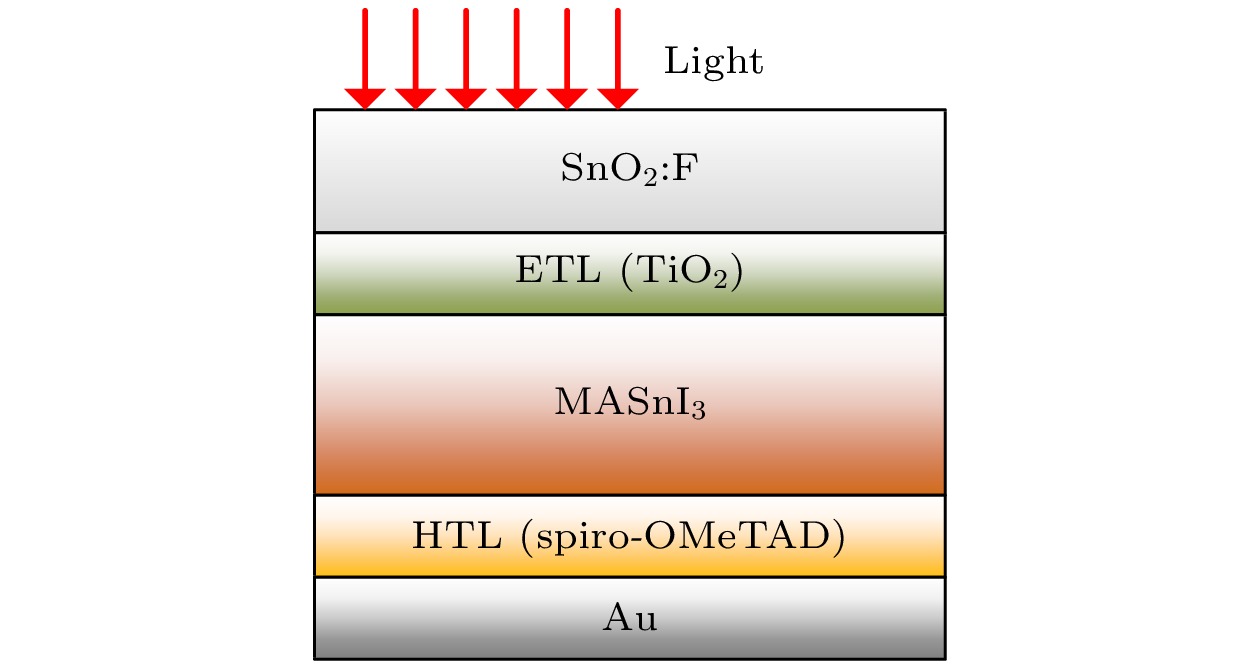
 DownLoad:
DownLoad:
